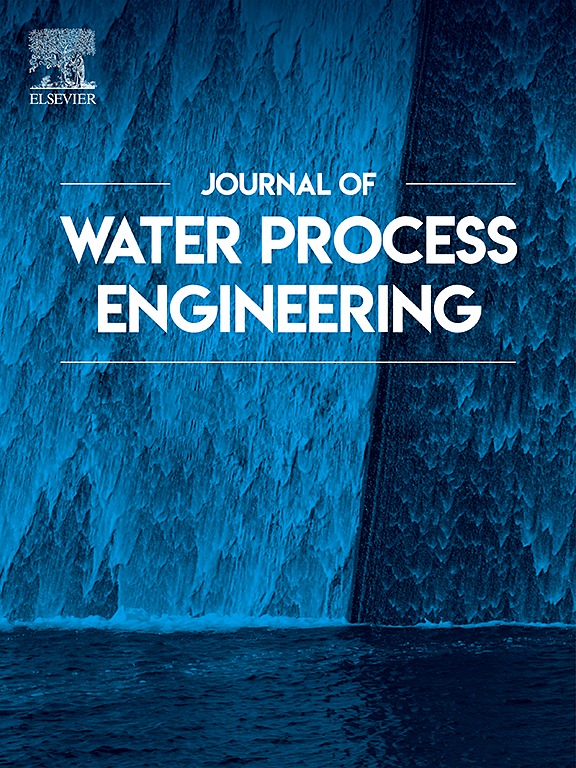Efficient degradation of dodecyl dimethyl benzyl ammonium chloride by activated carbon-loaded nanoscale zero-valent iron activated persulfate
IF 6.3
2区 工程技术
Q1 ENGINEERING, CHEMICAL
引用次数: 0
Abstract
Dodecyl dimethyl benzyl ammonium chloride (DDBAC) is a widely used antimicrobial disinfectant. Its extensive application results in wastewater containing disinfectants, which, if released directly into surface waters or wastewater treatment facilities, can pose significant threats to aquatic environments and ecosystems. To achieve efficient degradation of DDBAC, this study synthesized a novel catalyst, nZVI@AC, by loading nanoscale zero-valent iron (nZVI) onto activated carbon (AC). The catalyst effectively activates peroxydisulfate (PDS), establishing an advanced oxidation process (nZVI@AC/PDS) for the efficient degradation of DDBAC. Under optimal conditions, including an initial pH of 7, a catalyst dosage of 0.5 g L−1, and a PDS concentration of 1.5 mM, the removal efficiency of DDBAC (initial concentration of 10 mg L−1) achieved 90 % removal at 15 min. Moreover, the nZVI@AC/PDS system operates under mild reaction conditions, exhibits good adaptability to typical temperature ranges, and maintains stability across a wide pH spectrum. It also demonstrates strong resilience in the presence of coexisting interfering anions and consistently achieves high DDBAC removal efficiencies across a range of concentrations. These findings indicate that the nZVI@AC/PDS system has promising potential for the treatment of refractory quaternary ammonium wastewater. These findings indicate that the nZVI@AC/PDS system has promising potential for practical applications, particularly in medical wastewater treatment and advanced treatment processes in wastewater treatment plants. Electron paramagnetic resonance (EPR) analysis and radical quenching experiments confirmed that superoxide radicals (O₂•-) and sulfate radicals (SO₄•-) play a critical role in the degradation process. High-resolution mass spectrometry coupled with liquid chromatography (HPLC-MS) identified the reaction intermediates, and the degradation pathways were predicted, involving hydrogen abstraction, dealkylation, demethylation, hydroxylation, and benzyl C![]() N bond cleavage reactions. Density functional theory (DFT) calculations further corroborated the plausibility of the proposed reaction mechanism. Furthermore, the toxicity of DDBAC and its degradation intermediates was assessed. These findings provide novel insights into the degradation of DDBAC and demonstrate the promising potential of the nZVI@AC/PDS system for real-world disinfection wastewater treatment applications. The results highlight the potential of the nZVI@AC/PDS system for real-world applications, offering an efficient and stable solution for treating refractory disinfectant wastewater.
N bond cleavage reactions. Density functional theory (DFT) calculations further corroborated the plausibility of the proposed reaction mechanism. Furthermore, the toxicity of DDBAC and its degradation intermediates was assessed. These findings provide novel insights into the degradation of DDBAC and demonstrate the promising potential of the nZVI@AC/PDS system for real-world disinfection wastewater treatment applications. The results highlight the potential of the nZVI@AC/PDS system for real-world applications, offering an efficient and stable solution for treating refractory disinfectant wastewater.
活性炭负载纳米级零价铁活化过硫酸盐高效降解十二烷基二甲基苄基氯化铵
十二烷基二甲基苄基氯化铵(DDBAC)是一种应用广泛的抗菌消毒剂。它的广泛应用导致含有消毒剂的废水,如果直接排放到地表水或废水处理设施中,会对水生环境和生态系统造成重大威胁。为了实现对DDBAC的高效降解,本研究通过在活性炭(AC)上负载纳米级零价铁(nZVI)合成了一种新型催化剂nZVI@AC。该催化剂有效活化过硫酸氢盐(PDS),建立了高效降解DDBAC的高级氧化工艺(nZVI@AC/PDS)。在初始pH为7,催化剂用量为0.5 g L−1,PDS浓度为1.5 mM的最佳条件下,dbac的去除率(初始浓度为10 mg L−1)在15 min内达到90%。此外,nZVI@AC/PDS系统在温和的反应条件下工作,对典型温度范围具有良好的适应性,并在较宽的pH谱范围内保持稳定性。它还在共存的干扰阴离子存在下表现出很强的弹性,并在各种浓度范围内始终保持高的DDBAC去除效率。研究结果表明,nZVI@AC/PDS系统在处理难处理季铵废水方面具有广阔的应用前景。这些发现表明nZVI@AC/PDS系统在实际应用中具有很大的潜力,特别是在医疗废水处理和污水处理厂的深度处理过程中。电子顺磁共振(EPR)分析和自由基猝灭实验证实,超氧自由基(O₂•-)和硫酸盐自由基(SO₄•-)在降解过程中起关键作用。高分辨率质谱联用液相色谱(HPLC-MS)鉴定了反应中间体,并预测了降解途径,包括氢提取、脱烷基、去甲基化、羟基化和苄基CN键裂解反应。密度泛函理论(DFT)计算进一步证实了所提出的反应机理的合理性。此外,还评估了DDBAC及其降解中间体的毒性。这些发现为DDBAC的降解提供了新的见解,并展示了nZVI@AC/PDS系统在实际消毒废水处理应用中的良好潜力。研究结果突出了nZVI@AC/PDS系统在实际应用中的潜力,为处理难处理的消毒废水提供了一种高效、稳定的解决方案。
本文章由计算机程序翻译,如有差异,请以英文原文为准。
求助全文
约1分钟内获得全文
求助全文
来源期刊

Journal of water process engineering
Biochemistry, Genetics and Molecular Biology-Biotechnology
CiteScore
10.70
自引率
8.60%
发文量
846
审稿时长
24 days
期刊介绍:
The Journal of Water Process Engineering aims to publish refereed, high-quality research papers with significant novelty and impact in all areas of the engineering of water and wastewater processing . Papers on advanced and novel treatment processes and technologies are particularly welcome. The Journal considers papers in areas such as nanotechnology and biotechnology applications in water, novel oxidation and separation processes, membrane processes (except those for desalination) , catalytic processes for the removal of water contaminants, sustainable processes, water reuse and recycling, water use and wastewater minimization, integrated/hybrid technology, process modeling of water treatment and novel treatment processes. Submissions on the subject of adsorbents, including standard measurements of adsorption kinetics and equilibrium will only be considered if there is a genuine case for novelty and contribution, for example highly novel, sustainable adsorbents and their use: papers on activated carbon-type materials derived from natural matter, or surfactant-modified clays and related minerals, would not fulfil this criterion. The Journal particularly welcomes contributions involving environmentally, economically and socially sustainable technology for water treatment, including those which are energy-efficient, with minimal or no chemical consumption, and capable of water recycling and reuse that minimizes the direct disposal of wastewater to the aquatic environment. Papers that describe novel ideas for solving issues related to water quality and availability are also welcome, as are those that show the transfer of techniques from other disciplines. The Journal will consider papers dealing with processes for various water matrices including drinking water (except desalination), domestic, urban and industrial wastewaters, in addition to their residues. It is expected that the journal will be of particular relevance to chemical and process engineers working in the field. The Journal welcomes Full Text papers, Short Communications, State-of-the-Art Reviews and Letters to Editors and Case Studies
 求助内容:
求助内容: 应助结果提醒方式:
应助结果提醒方式:


